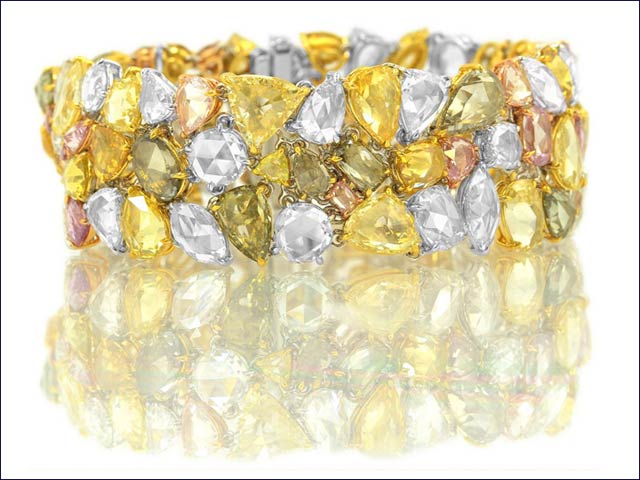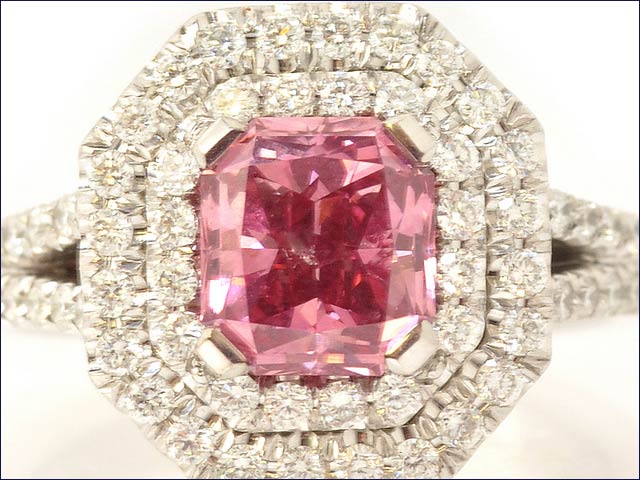By Avigayil Kadesh
The most coveted diamonds these days – to wear, collect and invest in -- sparkle in shades of pink, yellow, blue, violet, champagne and many other hues. Of the millions of diamonds mined globally each year, the gem industry estimates that only one in every 10,000 carats is colored.
Several Israeli diamond merchants deal in these stones, the likes of which adorn the necks and fingers of celebs including Jessica Biel, Carrie Underwood, Jennifer Lopez, Mariah Carey and Heidi Klum. One of the world's leading brands for conflict-free colored diamonds is Ramat Gan-based Leibish & Co. Fancy Color Diamonds (
www.Fancydiamonds.net), Israel’s only online purveyor of colored diamond jewelry. Its brick-and-mortar sales offices are in Israel, New York and Hong Kong.
The family business encompasses founder Leibish Polnauer, his wife Rosalind and their children Yossi (CEO), Chavi (jewelry designer), Shmulik (head buyer), Itzik (ecommerce manager) and Yoni (project manager). Each is a major industry player; Itzik was the only Israeli nominated as Young Leader of the Year at the 2012 competition held by the journal Jewellery News Asia.
Politics and religion is irrelevant in the world of fancy diamonds. Orders come even from Malaysia, Indonesia and Saudi Arabia. But the bulk of Leibish customers are North American, British, Australian and Asian.
According to marketing manager Benji Margolese, at least 85 percent of the customers simply desire a unique piece of jewelry -- engagement rings are top sellers – but a growing percentage is purchasing for investment purposes.
In fact, high-quality colored diamonds outperform platinum and gold, as well as white diamonds, in return on investment. Between 2002 and 2012, the price of a half-carat pink diamond increased by 375%, while a colorless diamond of the same size appreciated by just 10%. A 3.17-carat blue diamond sold in 2006 for $1 million was resold for $2.3 million five years later.
‘Not just boxloads of diamonds in the safe’
Hungarian-bred Leibish Polnauer started out as a polisher. In 1979, two years after immigrating to Israel from New York, he sourced some rare pear-shaped brown diamonds for London’s Royal Crown jeweler Garrad, and so began a career in what’s known as “fancy” diamonds.

A 54-carat multicolored diamond bracelet goes for $162,000 “Colored diamonds are fascinating in appearance and timeless beauty,” says Polnauer, who moves about $25 million in product per year. “Their rarity is outshining white stones.”
He and Shmulik travel the world to bid on the limited stock available, gaining a reputation for spending top dollar (“If you pay more than the other guys, you get the stones,” as Polnauer puts it) because rather than taking stock “on memo,” they own every gem they sell.
Founded in 1999, Leibish & Co. built its initial success on offline business to the trade, which today accounts for 35-40% of the company’s overall revenue. But in 1995, Polnauer took the bold step of opening a retail website, a move that many considered foolish at the time.
“Ten or 15 years ago it was innovative to sell diamonds to someone on the other side of the world online,” says Yossi Polnauer, “but now it’s an accepted way for clients to save money because of lower overhead and wider selection.”
The goods – loose diamonds or, increasingly, finished pieces designed and manufactured in Israel – are delivered via FedEx courier or through Malca Amit, Israel’s international armored courier service.
“People are a bit scared to make a huge investment online, but we do everything we can to give excellent pictures and videos of the products, along with all the certification and specs, and slowly but surely, [online marketing] is gaining acceptance all over the world,” says Margolese.
The company employs a full-time photographer and search-engine optimization team to make online buying as dynamic as possible. “It’s not just boxloads of diamonds in the safe,” says Polnauer.
Color is king
The value of colored diamonds is determined by the brilliance of their hue. “Color is king in fancy diamonds,” says Margolese.
He explains that the colors, while rare, are naturally occurring. A white diamond is made only of carbon, while the natural addition of nitrogen will turn the gem yellow and boron will turn it blue. Green diamonds are an outcome of underground radiation, while pink results from pressure on the stone.
 The $1 million Prosperity Diamond ring
The $1 million Prosperity Diamond ring “You can spend $700 or $800 on a 14-point fancy pinkish brown, while you can spend a million on the ‘Prosperity Diamond’ [ring], a vivid pink stone of 1.68 carats,” he says. “It’s not so much bigger, but the color makes the difference.”
The Leibish website is getting a high-tech upgrade as the trend picks up. “We see potential for increased investment purchases,” says Margolese. “The more Hollywood celebrities are flashing colored diamond jewelry and building fashion trends, the more the value goes up. People are interested in this product.”
But you won’t see the Polnauer family sporting their products. For all appearances, they’re just a regular Israeli family. “We don’t drive Mercedes or wear $100,000 diamond rings,” says Leibish Polnauer with a laugh. “We leave all that to our customers.”